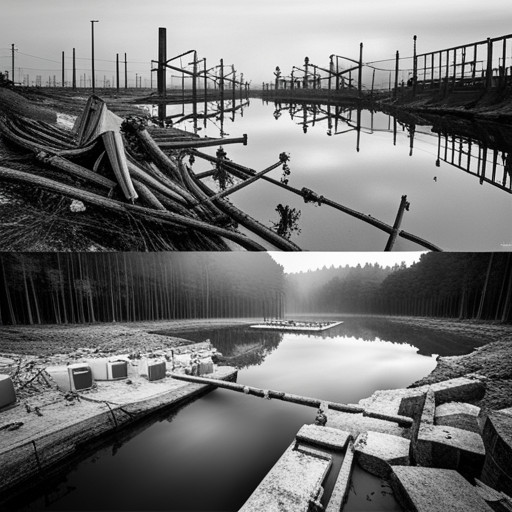Coverup and Compensation Camp Lejeune Water Contamination
Unveiling a significant environmental disaster, this article delves into the water contamination at Camp Lejeune, North Carolina.

Drawing parallels with the PG&E groundwater contamination, it explores the legislative response, the Camp Lejeune Justice Act, and the ongoing legal battles.
The narrative further uncovers personal accounts from survivors, examines health risks, and discusses the role of law firms in seeking justice for victims, offering an in-depth analysis of one of the largest contamination cases in US history.
Key Takeaways
- Camp Lejeune and PG&E lawsuits both involve a coverup by the respective organizations regarding the contamination of the local water supply.
- The Camp Lejeune Justice Act allows individuals who were stationed, lived, worked, or played at Camp Lejeune between 1953 and 1987 to file claims and lawsuits seeking compensation for water-related injuries.
- Survivors of Camp Lejeune water contamination have shared their experiences, highlighting the impact on their health and the development of cancer, including an increased risk of cancer in children born at Camp Lejeune.
- Delays in the Camp Lejeune Justice Act are causing additional problems for marine veterans seeking justice and compensation, but a committee of attorneys has been appointed to expedite lawsuits and provide quicker resolutions.
Unveiling the Parallels: Camp Lejeune and PG&E Groundwater Contamination

Parallels have been drawn between the groundwater contamination lawsuit involving PG&E and the coverup at Camp Lejeune, with both cases highlighting instances of organizational coverups of local water supply contamination. In both situations, the contamination led to severe health consequences for local residents.
Comparing legal processes, the PG&E case resulted in a court-ordered cleanup and significant financial compensation for victims. At Camp Lejeune, legal recourse is still ongoing, with the Camp Lejeune Justice Act enabling residents to file lawsuits for compensation.
Identifying long-term health effects has been a key component in both cases, with cancer and other serious illnesses linked to the respective contaminants. These cases illustrate the devastating effects of environmental negligence and underscore the importance of stringent regulation and oversight.
Navigating the Camp Lejeune Justice Act: A Guide to Claims and Compensation

Navigating the complexities of the Justice Act concerning a particular military base requires understanding the claims process and potential avenues for remuneration.
The Camp Lejeune Justice Act provides a legal platform for compensation eligibility, allowing individuals exposed to water contamination between 1953 and 1987 to file claims.
Town hall support plays a crucial role in disseminating information and assisting residents in seeking compensation.
It is noteworthy that no limit exists on the monetary compensation requested, but punitive damages are not permitted.
Furthermore, the filing of a Justice Act claim does not affect current benefits received by servicemembers.
Delays have been reported, however, a committee of seven attorneys aims to expedite the process, offering hope for quicker resolutions.
Updates and Developments: The Latest News on Camp Lejeune Water Lawsuits

Recent developments in ongoing litigation highlight survivors' experiences and potential health impacts associated with environmental hazards on a particular military base. The focus is on Camp Lejeune water contamination lawsuits, which have gained prominence due to the severe health consequences for those exposed.
Several survivors have shared their experiences, illuminating the devastating health implications of the contamination.
An increased risk of cancer has been noted in children born at Camp Lejeune.
Bellwether trials update: These trials are expected to set the compensation payout levels for plaintiffs.
A link has been established between Parkinson's disease and the water contamination.
Claims related to this contamination now include symptoms like anxiety tremors and erectile dysfunction.
These developments underscore the urgent need for justice and compensation for the survivors.
The Waiting Game: Understanding Delays and Expedited Lawsuits Under Camp Lejeune Justice Act

Delays in the implementation of the Justice Act have inadvertently imposed additional burdens on Marine veterans seeking resolution and equitable recompense for their grievances. These delays stem from a complex compensation process and the extensive effects of water contamination on health. To understand the impact of these delays, the table below presents data on the number of filed claims and approved compensations.
| Number of Filed Claims | Approved Compensations |
|---|---|
| 20,000+ | 8,500+ |
The disparity between the two figures underscores the urgency for expedited processes. Prolonged resolution not only exacerbates the physical and emotional toll on veterans but also prolongs their fight for justice. Therefore, comprehensive understanding and strategic implementations are crucial in addressing these concerns promptly.
Seeking Justice: Stories of Survivors and Affected Families at Camp Lejeune

Survivors and affected families at the aforementioned military base have shared heart-wrenching narratives, shedding light on the extensive health implications and emotional distress associated with the environmental disaster. These stories of resilience offer a stark contrast to the long road to justice:
- Experiences of survivors underline the physical and psychological toll of the contamination.
- Personal narratives highlight the enduring struggle for legal redress.
- Stories reveal an ongoing need for medical support and intervention.
- Accounts emphasize the importance of community support and resources.
- Narratives demonstrate the role of resilience in facing the aftermath of such a disaster.
The narratives serve as a poignant reminder of the human cost of environmental disasters, underlining the necessity for accountability, transparency, and the pursuit of justice.
Legal Aid: Resources and Firms Assisting With Camp Lejeune Justice Act Claims

Legal assistance, such as that provided by our law firm partners plays a crucial role in helping individuals navigate the complexities of filing claims under the Justice Act related to a certain military base's environmental disaster. These partner firms, along with many others offer valuable legal aid to those affected by the Camp Lejeune water contamination.
Their expertise in pharmaceutical and medical device litigation, and product liability cases, is essential in guiding claimants through the process. These legal resources not only assist in determining compensation eligibility, but also in expediting the claims process.
While state law claims are not pursued, these firms focus on federal law tort claims as per the Justice Act, ensuring those eligible receive the compensation they deserve.
The Impact of Contamination: Health Risks and Diseases Linked to Camp Lejeune’s Water

Exposure to volatile organic compounds and PFAS forever chemicals, present in the local water supply, has been linked to an increased risk of health issues such as cancer and Parkinson's disease among those who resided or worked in the affected military base between 1953 and 1987. The long term health effects are substantial and include:
- Increased risk of multiple types of cancer
- Development of Parkinson's disease
- Potential birth defects in children born during this period
- Increased risk of liver disease
- Potential for immune system disorders
Contaminated water diseases are a significant concern and underscore the necessity for thorough investigation and remediation efforts. The impact of these diseases on the health of those exposed to the contamination remains a critical area of study.
Frequently Asked Questions
What Are Some Other Notable Cases of Environmental Contamination in the US Besides the Pg&E and Camp Lejeune Incidents?
Notable instances of environmental contamination in the United States include the Love Canal Tragedy and the Cuyahoga River Fire, both marked by significant ecological damage and subsequent public health concerns.
What Are the Long-Term Effects of Exposure to Vocs and PFAS, the Chemicals Found in the Camp Lejeune Water Supply?
Long-term exposure to volatile organic compounds (VOCs) and per- and polyfluoroalkyl substances (PFAS) contributes to critical health issues, including cancer and hormonal disruption. Furthermore, VOCs negatively impact wildlife and PFAS disposal presents significant environmental challenges.
Are There Any Specific Precautions or Steps That Residents of Contaminated Areas Can Take to Minimize Their Health Risks?
Protective measures in contaminated areas include regular health check-ups to monitor potential effects, usage of safe water sources, and adherence to guidelines provided by health and environmental authorities to reduce exposure risks.
How Can the Families of Deceased Servicemembers Who Were Exposed to the Contamination at Camp Lejeune Seek Justice and Compensation?
Families of deceased servicemembers exposed to contamination at Camp Lejeune can seek justice and compensation through the Camp Lejeune Justice Act. This act permits claims for water-related injuries, fostering victim advocacy and ensuring government accountability.
What Are the Potential Legal Implications for the Parties Found Responsible for the Contamination at Camp Lejeune?
Potential legal implications for parties responsible for Camp Lejeune's contamination include accountability for environmental damage, health risks, and associated compensation claims, guided by legal precedents set in similar environmental contamination cases.

This post has been generated by AI and was not reviewed by editors. This is Not legal advice. Please consult with an attorney.




